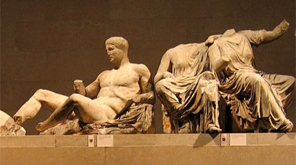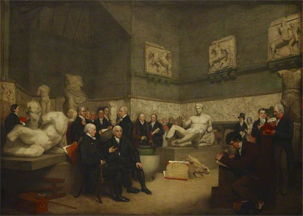LESSON ONE /
DISCOVERING THE
CLASSICAL PAST
|
In the 18th century archaeology was a new and rising field of learning, rapidly changing the ways Americans and Europeans thought about antiquity. |
Guiding Ideas and Themes
- The Grand Tour of Italy –– and notably the study of Rome –– by British and American figures starting in the 1700s sought first-hand acquaintance with classical antiquity.
- American Neoclassicism has its roots in British and continental scholarship, as archaeology evolved as a new field of study.
- During the 18th century the excavation of ancient ruins in the city of Rome and in Pompeii and Herculaneum near Naples revealed outlines of antiquity that had been previously lost and could only have been imagined.
- During the next hundred years illustrated books, engravings and translations became all-important means of popularizing newly discovered forms and artifacts from Rome and Greece.
- Neoclassicists admired and copied the Parthenon sculptures, also known as the Elgin Marbles. These reliefs from the Acropolis in Athens were moved to London after 1806, where they became 19th-century standards of classical perfection.
The Grand Tour and Joseph Addison
For American figures who traveled to Europe in the 18th century, London, France, and Italy were standard destinations on the Grand Tour. Rome was the ultimate destination. By the late 18th century it was a major cultural event and source of Neoclassical style.
The great essayist and literary critic Joseph Addison was a father of the Grand Tour and 18th century classicism. His Remarks on Several Parts of Italy, published in 1705, became a landmark guide for generations of British and American travelers seeking inspiration and information about Italy.
Addison’s journal helped inspire a vast field of scholarship and classical antiquarianism. Of Rome, Addison wrote:
There are in Rome two setts [sic] of Antiquities, the Christian and the Heathen. … Among the remains of Old Rome, the grandeur of the Commonwealth show it self chiefly in works that were either necessary or convenient, such as Temples, Highways, Aqueducts, Walls and Bridges of the City. On the contrary the magnificence of Rome, under the Emperors, is seen principally in such works as were rather for ostentation or luxury, than any real usefulness or necessity as in Baths, Amphitheaters, Circus’s, Obelisks, Triumphal Pillars, Arches and Mausoleums; for what they added to the Aqueducts was rather to supply their Baths and Naumachias, and to embellish the city with fountains, than out of any real necessity there was for them. These several remains have been so copiously described by abundance of travelers … that it is very difficult to make any new discoveries on so beaten a subject. There is however so much to be observed in so spacious a field of Antiquities, that it is almost impossible to survey them without taking new hints, and raising different reflections, according as a man’s natural turn of thoughts, or the course of his studies, direct him.
Addison observes that Roman antiquities are “so beaten a subject” and at the same time that “it is almost impossible to survey them without taking new hints, and raising different reflections.”
- How does this paradox still apply to the study of classics and antiquities?
Read and consider this astute description of the organized study of antiquities in 1764 Rome for visitors:
Rediscovering Roman Antiquity
Consider the impact of the rapidly growing demand for printed and illustrated books by 18th- and 19th-century scholars and the fast expanding reading public.
- How did books help popularize classical discoveries?
Archaeologists studied ruins, inscriptions, and artifacts (such items as pottery and coins). Ancient buildings and objects came in for serious study at excavations and then were reproduced in printed compilations. Bernard de Montfaucon (1655-1741), a French monk, is considered to be one of the founders of modern archaeology. From 1698 to 1701 he lived in Rome. He established his reputation with his 15-volume work, L’Antiquité expliquée et représentée en figures, published between 1719 and 1724, a vast, pictorial encyclopedia with copious engravings of the gods, heroes, religious customs, architecture, military practices, domestic habits, and funerary rites of the ancient world. It is a truly staggering and fascinating production that remained an unrivalled source book for the art of the ancient world for scholars and artists through the 19th century. It was immediately translated into English by David Humphreys as Antiquity Explained.
|
No better example of exciting 18th-century archaeological discoveries exists than Pompeii.
The excavation and archaeological discoveries of Pompeii and Herculaneum resulted in a folio collection, Le Antichità di Ercolano, an illustrated compendium of archeological finds from the excavations at the Roman city of Herculaneum. The books were profusely illustrated. They helped popularize the classics and fire the imagination both of Europeans and Americans, who used them as prototypes and models for modern designs. The volumes were published between 1744 and 1792, as the excavations continued. Many different artists and archeologists of the day worked on these books. This huge archaeological enterprise resulted in exquisite drawings of the ancient world that were widely circulated among tastemakers and connoisseurs. They had centuries-long influence on artists and architects.
A digital scan of Le Antichità di Ercolano
- For deeper study of the archaeology of Pompeii and Herculaneum, the following website provides an inexhaustibly rich, multi-faceted resource:
An outstanding lesson for advanced high school students covers the destruction of Pompeii:
A lesson on Pompeii for high school students
The Archaeological Institute of America website has abundant links, not only to Pompeii and the birth of archaeology but to many related websites and projects. It covers a vast field of research and investigation:
Links and topics from the Archaeological Institute of America
The Case of the Elgin (Parthenon) Marbles
The Parthenon sculptures, widely called the Elgin Marbles, have elicited attention ever since a career diplomat, Lord Elgin, was appointed British ambassador to Constantinople in 1799. Between 1801 and 1810, he arranged for the removal of the relief sculptures from the Parthenon on the Acropolis in Athens, which was still under Ottoman rule. What came to be known as the Elgin Marbles were shipped from Greece to England.
The Elgin Marbles and the Parthenon became standards of classical perfection. |
In 1816, Elgin was able to persuade the English government to consider the purchase of the Parthenon sculptures for the British nation. A Select Committee of the House of Commons was appointed, and on February 15, 1816, took expert testimony concerning the value of the sculptures. There is continuing debate over the propriety of the removal and their presence in the British Museum. Was Elgin a rescuer or thief? The debate continues today.
By 1900, all across the United States, in the form of plaster casts on walls and engravings displayed in classrooms, libraries and museums, the Elgin Marbles became commonly identifiable and known to American schoolchildren and artists, and all educated men and women. Their prominence in Anglo-American culture and influence in stimulating 19th-century enthusiasm about Greece and classical forms went unmatched.
Read the debate over the Elgin Marbles in Parliament and answer the study questions that follow.
Testimony in the House of Commons, given by several eminent artists, including the sculptors Joseph Nollekens (1737-1823) and John Flaxman (1755-1826), and the painters Sir Thomas Lawrence (1769-1830) and Benjamin West (1738-1820).
CHAIRMAN OF THE COMMITTEE to Joseph Nollekens:
“Mr. Nollekens, are you well acquainted with the collection of Marbles brought to England by Lord Elgin?” –
“I am.”
“What is your opinion of those Marbles, as to the excellency of the work?” --
“They are very fine – the finest things that ever came to this country.”
“In what class do you place them, as compared with the finest Marbles which you have seen formerly in Italy?” --
“I compared them to the finest in Italy.”
SIR THOMAS LAWRENCE, called in and examined.
“Are you well acquainted with the Elgin Marbles?” --
“Yes, I am.”
“In what class of art do you consider them?” --
“In the very highest.”
“Do you conceive any of them to be of a higher class than the Apollo Belvedere?” --
“I do; because I consider that there is in them an union of fine composition, and very grand form, with a more true and natural expression of the effect of action upon the human frame, than there is in the Apollo, or in any of the other most celebrated statues.”
For a less abridged transcript, go to Lorenz Eitner, ed., Neoclassicism and Romanticism, 1750-1850: Sources and Documents, vol. 1: Enlightenment / Revolution, Prentice Hall, 1970.
For Further Study
- For further study of the Elgin Marbles and their significance in Anglo-American fine arts, these two articles are recommended.
Marc Fehlmann, “Casts & connoisseurs: the early reception of the Elgin Marbles,” from Apollo (June 2007) is an excellent place to begin:
The early reception of the Elgin Marbles
Rochelle Gurstein, “The Elgin Marbles and the Waning of ‘Ideal Beauty’,” Daedalus (Fall 2002):
The impact of the Elgin Marbles on Neoclassical taste
- Did Lord Elgin save or steal the Acropolis sculptures?
- Using the case of the Elgin Marbles, explore the issue of “looting” cultural property and related issues of museology and archaeological preservation.
- In Who Owns Antiquity? Museums and the battle over our ancient heritage, art historian and museum director James Cuno examines a number of contemporary issues in matters of cultural property:
![]()



